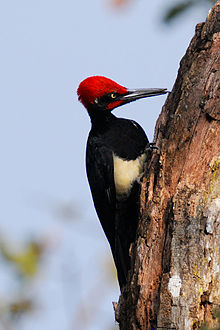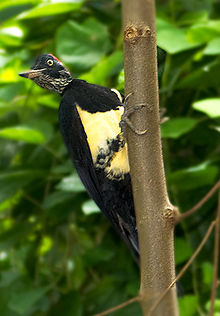- White-bellied Woodpecker
-
White-bellied Woodpecker D. j. hodgsonii Conservation status Scientific classification Kingdom: Animalia Phylum: Chordata Class: Aves Order: Piciformes Family: Picidae Genus: Dryocopus Species: D. javensis Binomial name Dryocopus javensis
(Horsfield, 1821)Subspecies see text
The White-bellied Woodpecker (Great Black Woodpecker, Dryocopus javensis) is found in evergreen forests of tropical Asia. It has 14 subspecies, part of a complex including the Andaman Woodpecker (Dryocopus hodgei) (earlier treated as a subspecies). Many island forms are endangered, some are extinct. Populations differ in the distribution and extent of white. They are among the largest of the Asiatic woodpeckers (between 42 and 48 centimetres and second in size only to the Great Slaty Woodpecker) and nest in large dead trees, often beside rivers. Their drums and calls are louder than those of the smaller woodpeckers.
Contents
Description
Cotigao NP, Goa, India Nov 1997
Subspecies hodgsonii has whitish underwing coverts and a white rump. The face lacks white but juveniles of the nominate race can have white streaks on the throat.[2] Differences from the other Southeast Asian subspecies in the vocalizations and morphology of this species are suggested to be large enough to raise this to full species status.[3] Solitary adults may spend an hour foraging at a suitable tree.[4] Subspecies hodgsonii of India breeds from January to May, mainly in large dead trees, often using the same tree year after year.[5] The normal clutch is usually of two eggs.[6] They feed mainly on insects such as ants[7] or grubs obtained mainly from under bark but sometimes take fruit.[8] Although shy, they can nest close to well used tracks and human disturbed areas.[5][9] They have a range of calls from a short, sharp "kuk" to more intoned "kyuk", "kew", "kee-yow" calls. The longer calls are given prior to flying off. They roost within holes.[4]
Subspecies
These subspecies are described:
- D. j. javensis (Horsfield, 1821) (southern Thailand to Borneo)
- D. j. philippinensis (Steere, 1890) (More often subsumed into the nominate)
- D. j. cebuensis Kennedy, 1987 (Cebu Island)
- D. j. confusus (Stresemann, 1913) (Luzon, includes esthloterus Parkes, 1971)
- D. j. feddeni (Blyth, 1863) (Thailand, Laos and Burma)
- D. j. forresti Rothschild, 1922 (Northern Myanmar and Sichuan, China)
- D. j. hargitti (Sharpe, 1884) (Palawan)
- D. j. hodgsonii (Jerdon, 1840) is found mainly in the Western Ghats of India but also known from central India[10] and the Eastern Ghats.[11][12]
- D. j. mindorensis (Steere, 1890) (Mindoro)
- D. j. multilunatus (McGregor, 1907) (Basilan, Dinagat, Mindanao)
- D. j. parvus (Richmond, 1902) (Simeulue Island)
- D. j. pectoralis (Tweeddale, 1878) (Samar, Bohol and other islands)
- D. j. richardsi Tristram, 1879 (Tristram's Woodpecker found in Korea, extinct on Tsushima)
- D. j. suluensis (W. Blasius, 1890) (Sulu)
The Andaman Woodpecker (Dryocopus hodgei) was treated as a subspecies in the past. The species has in the past been placed in the genus Thriponax and Macropicus.[13]
Behaviour and ecology
This large black woodpecker is usually seen singly or as a pair that may sometimes be accompanied by a third bird. They have a dipping in which the loud single note laugh like chiank call is produced. They also produce loud drumming especially in the breeding season. The breeding season is mainly January to March. The nest is built in a large dead tree often in open forest. Two white eggs are the usual clutch. In Bastar in central India, the squabs are sought after by tribals leading to the rarity of these birds.[13]
References
- ^ BirdLife International (2008). Dryocopus javensis. In: IUCN 2008. IUCN Red List of Threatened Species. Downloaded on 2 Oct 2009.
- ^ Robinson HC & FN Chasen (1939). Birds of the Malay Peninsula. Volume 4. H.F. & G. Witherby, London. pp. 286–288. http://rmbr.nus.edu.sg/biblio/robinson_chasen/vol4/22_Woodpeckers.pdf.
- ^ Rasmussen PC & JC Anderton (2005). Birds of South Asia: The Ripley Guide. Volume 2. Smithsonian Institution & Lynx Edicions. pp. 285–286.
- ^ a b Short, LL (1973). "Habits of some Asian Woodpeckers (Aves, Picidae)". Bull. Am. Mus. Nat. Hist. 152: 253–364. hdl:2246/603.
- ^ a b Santharam, V (2003). "Distribution, ecology and conservation of the White-bellied Woodpecker Dryocopus javensis in the Western Ghats, India". Forktail 19: 31–38. http://www.orientalbirdclub.org/publications/forktail/19pdfs/Santharam-Woodpecker.pdf.
- ^ Kinloch,AP (1923). "The nidification of the Malabar Great Black Woodpecker Thriponax hodgsoni". J. Bombay Nat. Hist. Soc. 29 (2): 561.
- ^ Abdulali,Humayun (1941). "The Great Black Woodpecker in the neighbourhood of Bombay". J. Bombay Nat. Hist. Soc. 42 (4): 933–934.
- ^ Santharam,V (1999). "Frugivory by the Great Black Woodpecker Dryocopus javensis". J. Bombay Nat. Hist. Soc. 96 (2): 319–320.
- ^ Neelakantan,KK (1975). "A day at a nest of the Great Black Woodpecker (Dryocopus javensis)". J. Bombay Nat. Hist. Soc. 72 (2): 544–548.
- ^ Ali,S (1951). "Discovery of the so-named 'Malabar' Black Woodpecker [Dryocopus javensis hodgsoni (Jerdon)] in Bastar (East Madhya Pradesh)". J. Bombay Nat. Hist. Soc. 49 (4): 787–788.
- ^ Blanford, WT (1895). Fauna of British India. Birds. Volume 3. Taylor and Francis, London. pp. 72–73. http://www.archive.org/details/faunaofbritishin025218mbp.
- ^ Morris, RC (1939). "On the occurrence of the Banded Crake (Rallus e. amuroptera) and the Malabar Woodpecker (Macropicus j. hodgsoni) in the Billigirirangan Hills, S. India". J. Bombay Nat. Hist. Soc. 40 (4): 763.
- ^ a b Ali S & SD Ripley (1983). Handbook of the birds of India and Pakistan. Volume 4 (2 ed.). Oxford University Press. pp. 208–210.
External links
Categories:- IUCN Red List least concern species
- Woodpeckers
- Birds of Asia
Wikimedia Foundation. 2010.




